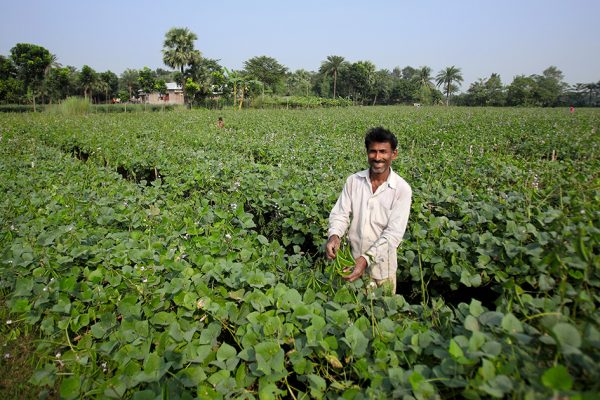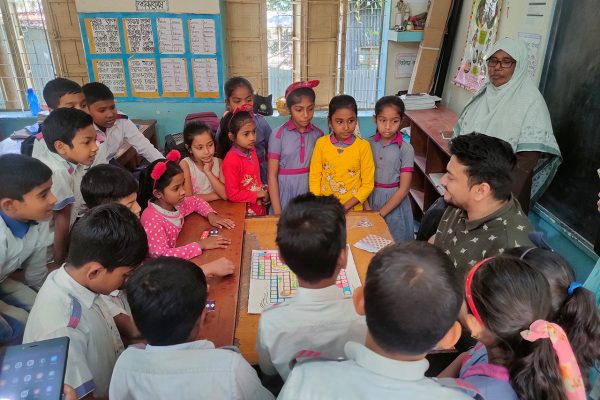Data for good: Doing development with digitalisation
Reading Time: 3 minutes
Communities across the globe are connected through the power of information and technology. Consumption patterns have been altered and traditional ways of working disrupted. How does this play out in the development sector?
BRAC’s Ultra-Poor Graduation programme has been evolving as the needs of the people living in extreme poverty change. In December 2021, the programme went digital, creating easier and faster ways of meeting our participants’ needs. In the 20-years journey of the programme, it’s one of the major milestones achieved.
Why was digitalisation needed?
The success of the Graduation approach can largely be attributed to the close interactions between participants and BRAC’s staff members. In the first 12 years of the programme’s operations, these interactions happened face to face, where staff members would spend the whole day in the field – visiting participants, collecting data on paper formats – then return to the office to transfer their collected information onto paper files.
In 2015, the process was made more efficient by having computers installed in all regional offices and introducing a management information system. However, it was in 2017 that the programme decided to digitise the whole operations to better support families living in ultra poverty.
At first, data was collected to view a participant’s progress and achievements against the Graduation indicators. However, we soon realised that the scope and utility can be expanded a lot more – the whole Graduation approach could be digital.
With the prospect of even better coordination, collaboration and execution among multi-level stakeholders, the team immediately started gathering new business requirements. More ambitious goals were set, starting from using data to identify participants living in extreme poverty, enrolling them through the digital platform, providing hands-on coaching digitally, keeping track of the programme’s community mobilisation and healthcare services in the system, followed by online monitoring the progress towards graduation from different stakeholder levels.

Staff following-up with participant’s progress using tab in home visit. BRAC ©2022
A layout of an advanced digital infrastructure for data-led decision-making was created. Operational needs of frontline staff members were assessed, to ensure that the application’s functionality reflected the staffs’ challenges on the field.
A human-centred approach was applied to design the interface and user experience, ensuring that field staff members were comfortable using the platform. The web-based and Android platforms followed multiple iterations of technologies to finally match the programme’s dynamic nature. Rigorous technical testing was conducted – with trainers, management and field staff – before launching the platform.
The software development was only half the battle. Staff members adapting to this change was crucial.
Instead of using the software development partners for training, a pool of field staff members were chosen as trainers. They were trained directly by the internal digitalisation project team, and then set out to cascade it down to the field workforce across Bangladesh. This ensured a smoother transition, as the staff were familiar with the programme’s operation and they could effectively train others by using programmatic knowledge and technical know-how.
A tripartite support team was formed, comprising the trainers, the programme’s technology unit, and the software development partner. The team’s job was to address queries and technical issues, taking away the load and traffic from the central team and external vendor and ensuring quick turnaround.
The result? A new platform that benefits staff of the frontlines, higher management and partners.
Field management team can now supervise, monitor and follow-up digitally, with the support of features like task management, scheduling, approval and preparing work plans for day-to-day activities. Over 2,700 staff members in approximately 244 offices across Bangladesh are now using this platform.
“I get instant reports from the field. The digital platform has transformed not just the way we work, but also the mindset we have – teams understand that data is a key driver in decision-making” – Pratima Rani, Regional Manager, Bagerhat.
The application that helps staff on the frontline to execute tasks with more ease and comfort. For example, staff do not need to manually remember when to give a vaccine to a participant’s livestock anymore, because they get automatic reminders in the system.

Head-office level monitoring using the system. Tayed Ahmed Khan, BRAC ©2022
Aggregated data from the field informs strategies and decisions, so centrally managers and strategic decision-makers also benefit.
We just got started, and the future holds even more potential.
The data and network infrastructure of the platform is compatible with big data – which means the database can be integrated with national and international portals, such as Bangladesh Bureau of Statistics, Sustainable Development Goals, business intelligence tools, and machine learning technologies, allowing management and development practitioners to get both prescriptive and predictive insights.
The annual socio-economic data of over 65,000 participants of the Ultra-Poor Graduation programme can also be stored digitally, which means researchers and other partners utilise the insights for development planning. Partners will benefit from getting to see the impact in real-time – all broadening the scope of development.
The dynamics of poverty are changing, and so are we. We are ready with our digitalisation approaches to always be relevant to the needs of the people we work with and to ensure support is reaching people even from the last mile.
BRAC’s Ultra-Poor Graduation programme is recognised worldwide as the pioneer of the Graduation approach and is acclaimed for its innovative and holistic solution to ultra-poverty. Our Graduation approach is a comprehensive, time-bound, integrated and sequenced set of interventions that aims to enable households living in ultra-poverty to achieve key milestones towards sustainable livelihoods and socioeconomic resilience, in order to progress along a pathway out of extreme poverty. Since it began in 2002, the programme has served over 2.1 million households living in ultra-poverty in Bangladesh, as of December 2020.
Tasnur Rahman Tonoy is a Manager, MIS and Technology, at BRAC’s Ultra-Poor Graduation programme
Tania Tasnin was a Manager, Knowledge Management and Communication at BRAC’s Ultra-Poor Graduation programme
Ahona Azad Choyti is a Communications Specialist at BRAC Communications.





